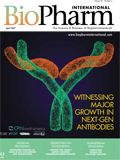Critical Quality Attributes Challenge Biologics Development
The complex nature of biologics adds additional CQAs that must be determined to ensure the safe development of biologics
Jirsak/shutterstock.com

Critical quality attributes (CQAs) are used in biopharmaceutical development to gain an understanding of a product and the processes used to make that product. The International Council for Harmonization (ICH) Q8 (R2) defines CQAs as “a physical, chemical, biological, or microbiological property or characteristic that should be within an appropriate limit, range, or distribution to ensure the desired product quality. CQAs are generally associated with the drug substance, excipients, intermediates (in-process materials), and drug product” (1). While CQAs of small-molecule drugs can affect the purity, strength, drug release, and stability of a drug, the complex nature of biologics can create additional quality attributes that can affect the safety and efficacy of the biologic (2). Identifying CQAs for biologics can, therefore, be a complicated process.
BioPharm International spoke with Tapan Das, head of stability, methods and analytical development at Bristol-Myers Squibb and Finance Committee member and past-chair of the BIOTEC Section at the American Association of Pharmaceutical Scientists (AAPS), about how CQAs for biologics differ from CQAs for small-molecule drugs and how they can be determined.
Challenges for biologics
BioPharm: Are there specific challenges to identifying CQAs in biologics when applying quality by design (QbD)?
Das (BMS): Knowledge-based design, as opposed to a heuristic approach, is a key principle of QbD. Determination of criticality of process and quality attributes improved significantly in the past decade with the advancement of knowledge in protein engineering, biology, and cell culture engineering. However, challenges remain, specifically in establishing criticality, when an attribute has the potential to impact a multitude of factors in the broad category of safety and efficacy. Protein modifications (such as post-translational modifications) and degradation products may affect potency as well as secondary pathways such as altered clearance or induction of immunogenicity.
BioPharm: How are CQAs in biologics defined?
Das (BMS): For recombinantly produced biologics, special attention is paid to the cell culture and purification process parameters as well as storage conditions because of their influence on heterogeneity commonly observed in biologics. It is the heterogeneity in biologics that makes the process of defining criticality of each heterogeneous species extremely challenging. Therefore, consistency of product quality becomes even more important for biologics.
BioPharm: What is the process for determining risk, specifically for biologics?
Das (BMS): Risk assessment is an evolving process from the discovery phase to clinical stages to product approval and commercial manufacturing. In the early discovery and development stages, criticality determination of each process parameter and quality attribute is not meaningful, rather the emphases are on establishing safety and biological function of the product and producing them in a consistent manner. When developing a commercial process and formulation, appropriate analytical, structural, and biological assays are developed that are capable of studying the components in a heterogeneous biologics product, and understand its impact on function, safety, stability, microbiological safety, and dosage form integrity.
Tools for determing CQAs
BioPharm: What tools can be used to determine CQAs for biologics?
Das (BMS): Criticality determination relies on understanding probability of occurrence and relevance of a given attribute or process parameter; identifying product variants, understanding its biochemical/biophysical properties, and establishing its link to process parameters; and studying impact on function (e.g., binding potency, clearance, antibody-dependent cell-mediated cytotoxicity [ADCC], etc.) and safety (toxicity, immunogenicity). As noted above, it is impractical to study all possible attributes of process and product in early stages to understand, at an individual level, its impact on function and safety.
BioPharm: Do some studies/tools work better than others? Why?
Das (BMS): This is an important point. Establishing appropriate analytical/biophysical/functional tools that are fit-for-purpose for sensitivity and specificity is key to ensure the known/hypothesized impacts (on structure, function, and safety) can be studied objectively. For example, during commercial development, enrichment studies can be conducted to study impact (and hence, criticality) of one variant at a time. Another example is use of state-of-the-art higher order structure tools, when needed (not suitable for routine use), to deconvolute structural impact from multiple degradations (e.g., oxidation, isomerization) occurring at the same time (3).
Regulations and risk assessment
BioPharm: Are the regulations for CQAs and QbD different for biologics? If yes, how?
Das (BMS): The ICH guideline [(ICH) Q8 (R2)] is commonly followed for CQA approaches and its use toward establishing a robust manufacturing process. Adoption of QbD differs greatly across regions including within the United States. However, the underlying principles of QbD (i.e., a systematic approach for product and process understanding and process control, based on sound science and quality risk management) towards developing robust process and product are increasingly used across regions.
BioPharm: As biologics become more popular in the industry, are companies paying more attention to risk assessment and QbD for these products?
Das (BMS): Generally, yes. Risk assessment still differs significantly across organizations. The past decade has experienced a tremendous growth in the biologics portfolio of the biopharmaceutical industry. With the advancement of knowledge in analytical sciences, protein engineering, biology, and cell-culture process, it is now possible to assess quality attributes more objectively than before. The awareness for the importance of CQA assessment and its critical role in developing robust process/product is also increasing.
References
1. ICH, Q8 (R2) Pharmaceutical Development (ICH, August 2009).
2. A. Rathore, A. Reason, and A. Weiskopf, BioPharm International 27 (7) (July 2014).
3. Yan et al., Anal Chem. 2016, 88, 2041-2050.
Article Details
BioPharm International
Vol. 30, No. 4
April 2017
Pages: 33-34
Citation
When referring to this article, please cite it as S. Haigney, "Critical Quality Attributes Challenge Biologics Development," BioPharm International 30 (4) 2017.
